If you’re wondering why tree roots are lifting your concrete slab, this is the article for you. Trees and their roots can become issues for concrete slabs if they’re placed too close. If you buy a house and notice tall old trees growing near your home, chances are you will have to relocate or remove them.
Why Are Tree Roots Lifting My Concrete Slab?
A tree’s roots can be twice as wide and deep as its canopy above. Larger trees like Pine, Oak, Willows, and American Elms have massive roots that can lift and crack your concrete slab. Lifted slabs are eyesores, trip hazards, and lower the value of your home. If tree roots are lifting your sidewalk, you might be able to move the slab rather than the tree. If the roots are lifting your driveway or the slab foundation under your home, you’ll need to move the tree.
If you decide to remove the tree, you’ll need to cut and tear out the roots under your slab. Or, you could wait for the roots to die, but that might take some time. Once the roots are gone, you’ll notice your concrete slab sink into the soil. That’s because the space left behind from the roots, combined with the moisture absorbed by the tree, will leave voids under your slab.
Now, you’re thinking you have to replace the concrete slab. But there’s a better solution: polyjacking.
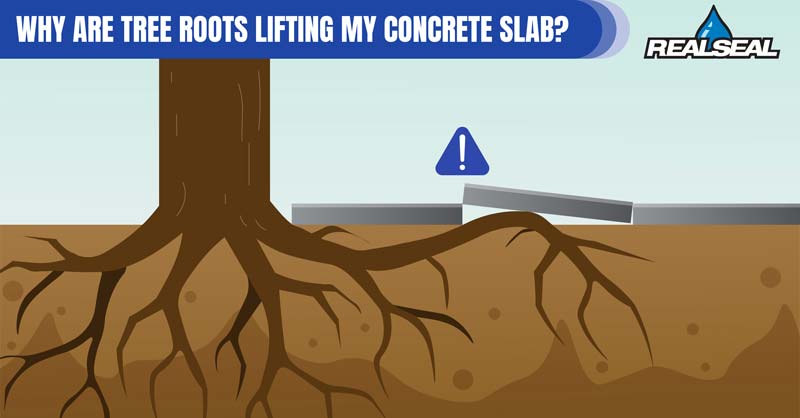
What Is Polyjacking?
Polyjacking involves pumping expanding polyurethane foam underneath your concrete slab until it’s leveled. This is the perfect solution for filling the voids under your concrete slab left by removed tree roots. Note: If tree roots have cracked your concrete slab too much, polyjacking may not be the best solution.
Polyjacking can be used on sidewalks, patios, driveways, pool decks, and interior concrete slabs, such as garage floors. Here’s how the process works.
- Small dime-sized holes are drilled into your sunken slab.
- Expanding polyurethane foam is injected through the holes into the void below.
- As the foam fills the void, it slowly lifts the concrete slab.
- Once the slab is leveled, experts stop pumping the foam and patch the holes.
- Fifteen minutes after the foam cures, you can walk or drive over your newly leveled concrete slab.
Other Common Issues
Tree roots are just one of many issues that can affect your concrete slab. Expansive soil can lift and sink your slab, cracking your concrete because of the constant movement. Here’s a little more detail into these other common issues.
Tree roots are just one of many issues that can affect your concrete slab.
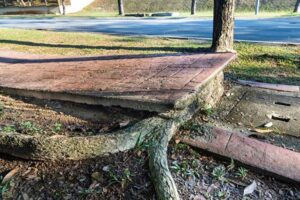
- Expansive soil – As mentioned above, expansive soil can lift and sink your concrete slab. That’s because expansive soil swells when it absorbs water and shrinks when it dries. Concrete slabs aren’t meant to move up and down.
- Drainage – Tree roots can tell if there’s an excess amount of moisture underneath your concrete slab. Experts always suggest grading your property, so your concrete slab isn’t at the bottom of a slope. Water from rain, clogged gutters, or poorly placed downspouts can drain downhill and seep into the soil below your slab. This can either wash the soil out from under your slab or cause the dirt to swell.
- Compaction – Before your concrete slab was poured and formed, contractors should have compacted the dirt at the site. This eliminates any spaces between the soil particles, lowering the chance your heavy slab will sink. If this process isn’t done, the soil will settle into the open spaces, leaving gaps between your slab and dirt.
Why Is Polyjacking Better Than Replacing?
If you decide you want to replace your concrete slab rather than using polyjacking, you might save a few dollars in the beginning. But over time, the new slab will sink into the same voids that sunk your last one. Unless your concrete was made incorrectly, the issue is the soil, not the slab.
Polyjacking is faster – Once the foam cures under your slab, you can drive or walk over your concrete. If you replace your slab, you’ll need to wait at least 48 hours for the fresh concrete to cure.
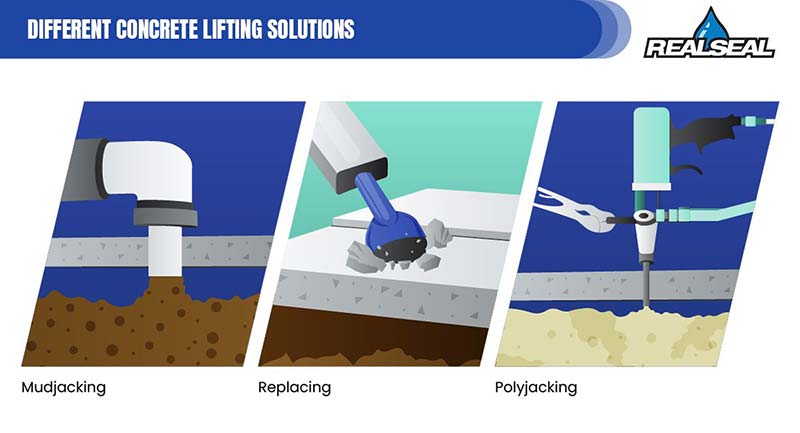
Replacing a slab involves chipping and hauling away the old concrete before you can even pour the new one.
- Polyjacking is cleaner – Replacing a slab involves chipping and hauling away the old concrete before you can even pour the new one. Then, someone will park their large concrete mixing truck on your property, which can damage your yard and leave a large mess. Polyjacking requires small handheld injection pumps and a hose that leads back to a truck. There’s no need for excavators or trenching machines.
- Polyjacking is lighter – As we mentioned before, a new slab will still push down on your weak or void-filled soil, causing it to sink again. The polyurethane foam used in polyjacking only weighs between 2.5 to 4 pounds per cubic foot.
- Polyjacking is safe – The foam used in polyjacking is inert and non-toxic, so you don’t need to worry about chemicals killing your grass or flowers.
- Polyjacking is cheaper – If you replace your concrete slab, you’ll just have to replace it again in a few months once it sinks. Polyjacking solves the problem the first time, saving you money.
Polyjacking is long-lasting – Polyjacked concrete will last indefinitely (unless you still have drainage issues washing away more soil). Polyjacking foam is also hydrophobic and won’t wash away during a storm.
Read more – Benefits of Concrete Leveling With Poly-Jacking
Who Can Help?
If your concrete slab is lifting or sinking, or trees are affecting your foundation, call The Real Seal. We don’t remove or relocate trees, but we do provide the best polyjacking/concrete leveling services in Chicagoland. Call today for your free inspection and quote.
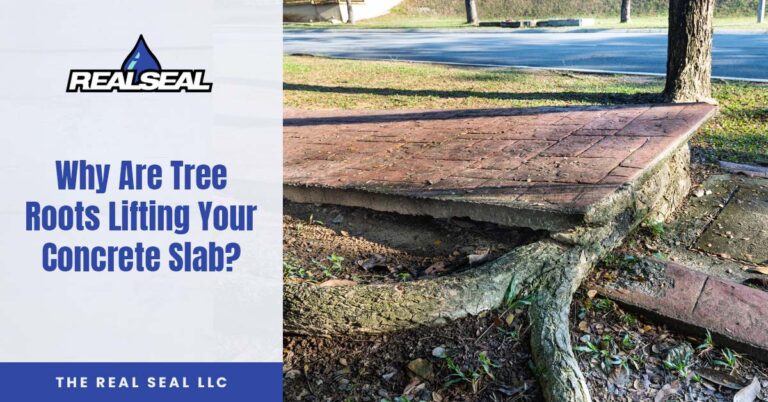
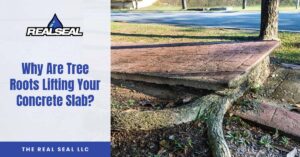





4 Responses
We need an expert to give us a quote on slab repair. Can you recommend?
Hi Debra,
Where are you located? Depending on where you are, we may have a recommendation.
We need an advice on how best to kill a tree “stump” and its roots. It’s not a trunk, because the tree has been cut down to a stump. However, it’s still somehow continuing to lift our concrete and our backyard. Please advise what is needed and how to apply product to kill tree stump and root.
Hi Elizabeth!
An arborist is likely what you need here, but I suspect a stump grinder could be useful. You can rent them at any major tool rental store. I do not know about the products to apply in order to kill the stump.